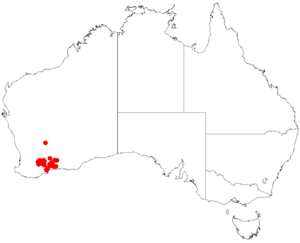Leptospermum inelegans facts for kids
Quick facts for kids Leptospermum inelegans |
|
|---|---|
| Scientific classification | |
| Genus: |
Leptospermum
|
| Species: |
inelegans
|
 |
|
| Occurrence data from AVH | |
Leptospermum inelegans is a type of bushy plant, also called a tea-tree. It grows naturally only in Western Australia. This plant has young stems that are a bit hairy. Its leaves are shaped like eggs or narrow ovals and grow on short stalks. It has small white or pink flowers. When its fruit is ripe, it falls off the plant.
What it Looks Like
Leptospermum inelegans is a straggly shrub. This means it grows in a loose, sprawling way. It usually reaches a height of about 1 to 2 meters (3 to 6.5 feet). Older branches have thin, rough bark. The younger stems are only partly covered with fine hairs.
Its leaves are shaped like eggs or narrow ovals. They are usually 5 to 15 millimeters (0.2 to 0.6 inches) long. They are also about 2 to 3 millimeters (0.08 to 0.12 inches) wide. These leaves grow on short stalks called petioles.
The flowers are white or pink. They are quite small, about 7 to 10 millimeters (0.28 to 0.39 inches) wide. Each flower usually grows alone on a short side shoot. The base of the flower, called the floral cup, is 2 to 3 millimeters (0.08 to 0.12 inches) long. It has flat, silky hairs and sits on a tiny stalk, or pedicel, less than 1 millimeter long.
The sepals, which are like small leaves protecting the bud, are triangular and about 2 millimeters long. The petals, the colorful parts of the flower, are about 3 millimeters long. The stamens, which produce pollen, are less than 1 millimeter long. This plant mainly flowers from September to November.
After flowering, the plant produces a fruit. This fruit is a capsule, which is a dry seed pod. It is 3 to 4 millimeters (0.12 to 0.16 inches) long. The remains of the sepals stay attached to the capsule. Once the seeds are released, the capsule falls off the plant.
Its Name and Discovery
The plant Leptospermum inelegans was first officially described in 1989. This description was made by a botanist named Joy Thompson. She published her findings in a science journal called Telopea. The plants she studied were collected by Roger Hnatiuk.
The second part of its scientific name, inelegans, comes from a Latin word. It means "not choice" or "tasteless." This name refers to how the plant usually looks, which is often a bit plain or straggly.
Where it Lives
This type of tea-tree is usually found in areas with scrub or heathland. It grows on hills and gently rolling plains. You can find it in certain parts of Western Australia. These areas include the Coolgardie, Esperance Plains, and Mallee biogeographic regions. These are special areas defined by their unique plants and animals.
How it's Protected
The Western Australian Government's Department of Parks and Wildlife keeps track of plant species. They have classified Leptospermum inelegans as "not threatened." This means that, for now, there are enough of these plants in the wild, and they are not considered to be in danger of disappearing.

